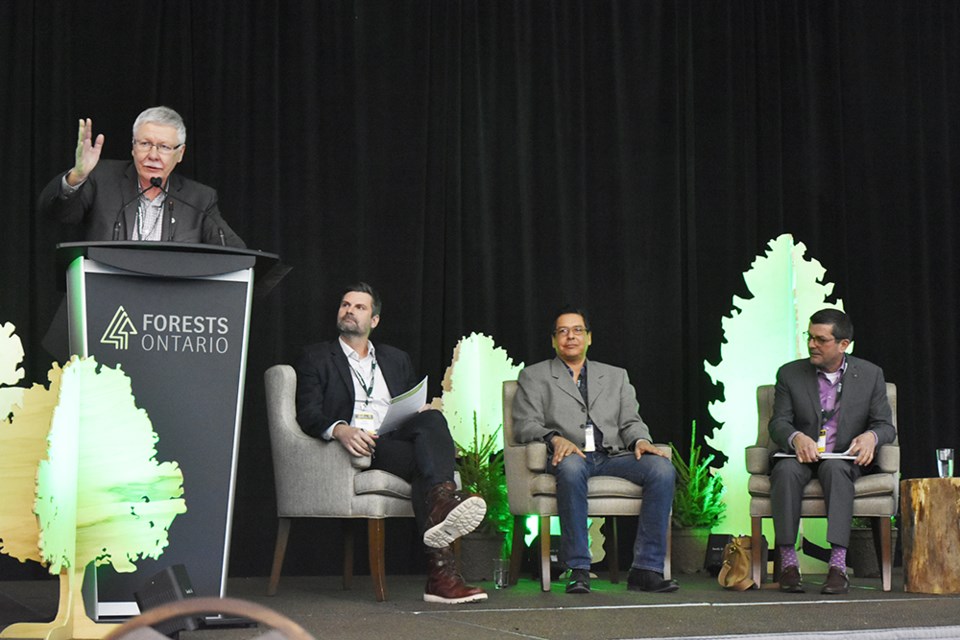Forests Ontario’s annual Forestry Conference did not ignore the elephant in the room: climate change.
The impact of drought on seedling survival, an increase in wildfires, the spread of invasive insects and tree diseases were topics of discussion, along with the potential for tree-planting to mitigate some impacts of climate change.
That’s especially true in an urban environment, said Jade Schofield of the Town of Ajax. The municipality recently partnered with NASA, using the space agency’s earth observations to assess the correlation between urban forestry and extreme heat.
Schofield noted there has been an overall increase in average temperatures of about 4 C since the 1800s. Every model predicts a continuing increase in the number of days over 30 C, and even 35 C, towards the middle of the century, as well as more severe rainfall events “followed by long periods of drought.”
The changes are predicted to have “significant impact to human health,” she said, especially for vulnerable populations. The rising temperatures are also expected to correlate with a decrease in air quality, increase in vector-borne diseases, and increase in weather-related natural hazards, from falling tree limbs, to flooding.
Urban trees are at risk from drought, ice storms, high winds – but may also play a “big role” in mitigation through strategic planting, Schofield said. Trees provide shade and cooling, and, when properly located, can contribute to energy conservation. They remove pollutants and greenhouse gases, and can prevent erosion.
The NASA observations helped Ajax identify areas of maximum heat, which largely coincided with the most vulnerable populations, and determine where “trees could be planted to optimize their effectiveness, where we could prioritize forest management,” Schofield said, adding trees are not only impacted by climate change, “they can help us adapt."
The town plants 57 tree species, “primarily maple,” she said, and it was able to use the data to identify which species are vulnerable to rising temperatures and drought, “where we do have vulnerable trees, and where we do need to take action as soon as possible.”
Despite windstorms, ice damage, and losses caused by emerald ash borers, Ajax still managed to increase its tree canopy from 17.5 per cent to 22 per cent.
Ajax is unique, she admitted. Although many of the older homes in the downtown core have been adapted for low income housing, they still have large lots, conducive to planting. While the municipality can’t plant on private property, it can provide financial incentives to encourage owners to plant “the right tree in the right place.”
Other impacts of climate change were more immediate.
Jim Rook, of the municipality of Killarney, shared at the conference “what it feels like to be in a forest fire that’s out of control.”
The Parry Sound 33 fire rapidly spread in July and August of 2018 “due to the very dry conditions. I’ve never seen it so dry,” said Rook.
Rook noted the fire highlighted gaps in public safety planning and risk management that are now being addressed, including the steps needed to work towards becoming a “fire smart” municipality.
“We have 100 years of pine needles on the ground, we’ve got an understory of juniper. It’s gasoline,” he said, highlighting the need for a new approach to forest fires, and for a “better relationship” with neighbouring municipalities and private corporations to share resources and expertise.
“What we’re doing now is adapting.”
Derek Nighbor, CEO of the Forest Products Association of Canada (FPAC), called on governments to play a bigger role in “vulnerability assessment” and risk mitigation, to preserve Canada’s forests.
“Our industry is changing. Our industry isn’t what it used to be, but it’s still an important economic driver,” Nighbor said. “We at FPAC believe there has to be a national conversation. We know very clearly that climate change is happening.”
Across Canada, commercial harvesting removes only 0.5 per cent of the 347,069,000 hectares of forest every year – while fire destroys 0.4 per cent, and insect damage, five per cent.
Not only is there a need to address the impacts of climate change, drought and invasive species, there is a need for innovation, improved infrastructure, and better transportation networks, he said.
“Canada is still the No. 1 exporter of wood and wood products in the world,” said Nighbor, but there is a need to work together to overcome challenges.
Steve Hounsell, president of Forests Ontario, summed it up: “Disturbances are amplified and continue to be amplified by human activity, including climate change. We are a part of and not apart from the natural world.”


